IASbaba's Daily Current Affairs Analysis
Archives
(PRELIMS + MAINS FOCUS)
Place in news: Thousand Islands
Part of: GS Prelims and GS-II – International relations
In news
- On 9 January 2021, a Boeing 737-500 (PK-CLC) operating Sriwijaya Air Flight 182 went missing after taking off from Jakarta Soekarno–Hatta Airport on route to Pontianak Supadio Airport.
- The aircraft crashed near the Thousand Islands.
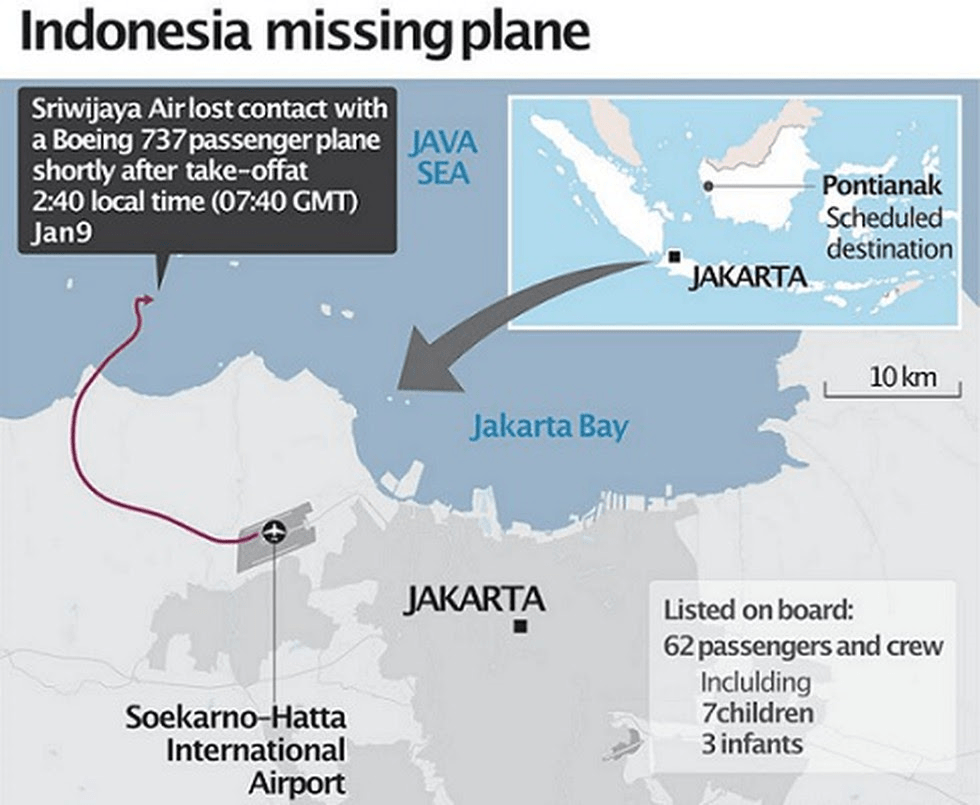
Important value additions
- The Thousand Islands (officially Kepulauan Seribu) are a chain of islands to the north of Jakarta’s coast.
- It forms the only regency of Jakarta, the capital of Indonesia.
- It consists of a string of 342 islands stretching 45 km (28 mi) north into the Java Sea at West Jakarta Bay and in fact north of Banten Province.
Arunachal Pradesh likely to become India’s prime producer of Vanadium
Part of: GS Prelims and GS-III – Economy; Sci & Tech
In news
- Arunachal Pradesh is likely to become India’s prime producer of vanadium.
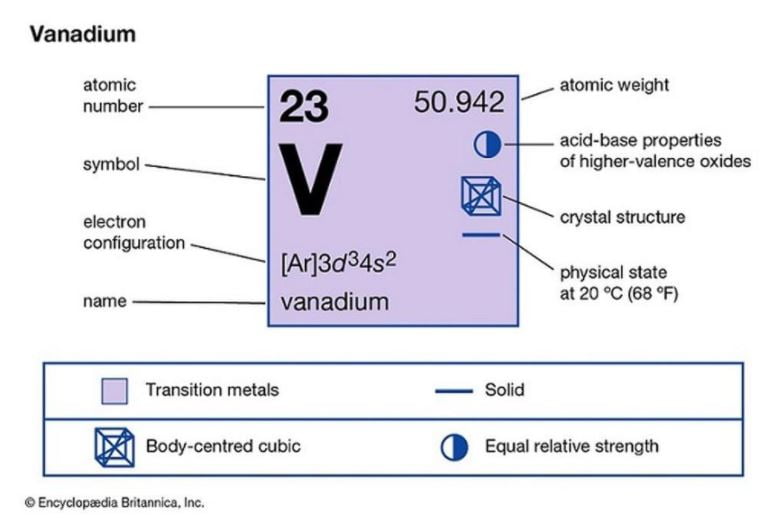
Key takeaways
- The largest deposits of vanadium in the world are in China, followed by Russia and South Africa.
- China, which produces 57% of the world’s vanadium, consumed 44% of the metal in 2017.
- India is a significant consumer of vanadium, but is not a primary producer of the strategic metal.
- According to data provided by the GSI, India consumed 4% of about 84,000 tonnes of vanadium produced across the globe in 2017.
- The Geological Survey of India (GSI) found promising concentrations of vanadium in the palaeo-proterozoic carbonaceous phyllite rocks in the Depo and Tamang areas of Papum Pare district in Arunachal Pradesh.
- This was the first report of a primary deposit of vanadium in India, with an average grade of 0.76% V2O5 [vanadium pentoxide].
- Vanadium mineralisation in Arunachal Pradesh is geologically similar to the “stone coal” vanadium deposits of China hosted in carbonaceous shale.
- This high vanadium content is associated with graphite, with a fixed carbon content of up to 16%.
Important value additions
- Vanadium is a chemical element with the symbol V and atomic number 23. It is a hard, silvery-grey, malleable transition metal.
- The elemental metal is rarely found in nature. It is recovered as a by-product from the slag collected from the processing of vanadiferous magnetite ores (iron ore).
- Vanadium is a high-value metal used in strengthening steel and titanium.
High Speed Rail work gathers momentum for Delhi – Varanasi High Speed Rail Corridor with the start of LiDAR (Aerial Ground) Survey
Part of: GS Prelims and GS-III – Economy; Sci & Tech
In news
- With the start of LiDAR (Aerial Ground) Survey, High Speed Rail work gathered momentum for Delhi – Varanasi High Speed Rail Corridor.
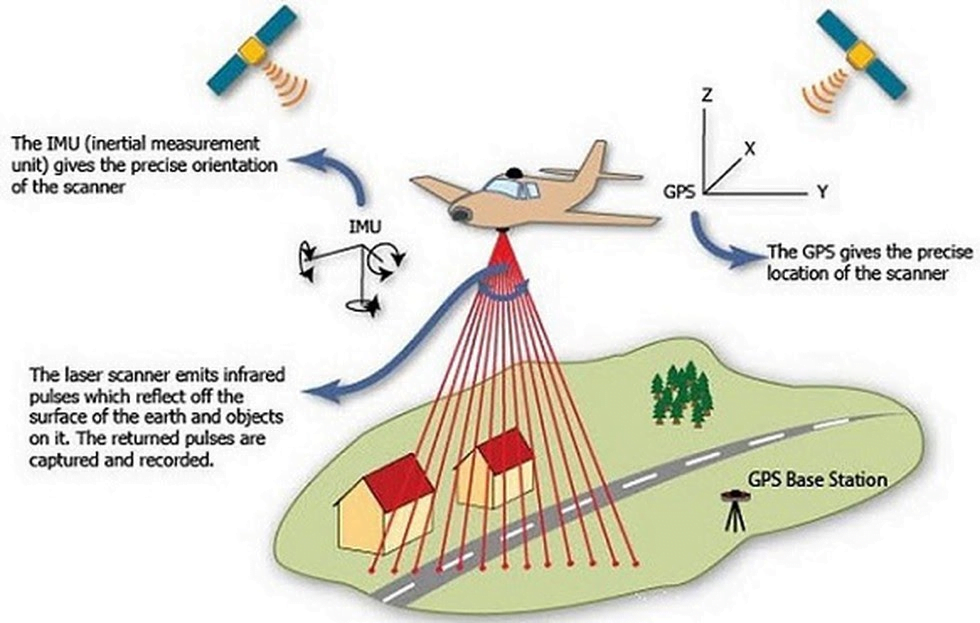
Key takeaways
- The LiDAR survey for Delhi-Varanasi High Speed Rail Corridor started from Greater NOIDA where a Helicopter fitted with state of art Aerial LiDAR and Imagery sensors took the first flight and captured the data related to ground survey.
- National High Speed Rail Corporation Limited is adopting Light Detection and Ranging Survey (LiDAR) technology which provides all the ground details and data in 3-4 months wherein this process normally takes 10-12 months.
- The ground survey is a crucial activity for any linear infrastructure project as the survey provides accurate details of areas around the alignment.
Important value additions
LiDAR
- Lidar, which stands for Light Detection and Ranging, is a remote sensing method that uses light in the form of a pulsed laser to measure ranges (variable distances) to the Earth.
- These light pulses—combined with other data recorded by the airborne system— generate precise, three-dimensional information about the shape of the Earth and its surface characteristics.
- A LiDAR instrument principally consists of a laser, a scanner, and a specialized GPS receiver.
- This technology is mostly used for ground-based surveys.
- LiDAR was first used on a spacecraft during the Apollo 15 mission in 1971, when astronauts mapped the surface of the moon.
- Apart from aerial surveys, the LiDAR sensor is the most important component in self-driving cars. The LiDAR sensor provides continuous 360 degrees of visibility and accurate depth information.
Do you know?
- Airplanes and helicopters are the most commonly used platforms for acquiring the data.
- It can be used to examine both natural and manmade environments with accuracy, precision, and flexibility.
- Two types of LiDAR are:
- Topographic typically uses a near-infrared laser to map the land
- Bathymetric uses water-penetrating green light to measure seafloor and riverbed elevations.
Related articles:
- About LiDAR: Click here
- Prehistoric settlements discovered through Light Detection and Ranging (LiDAR) data: Click here
Supermassive Black Hole seems to go missing
Part of: GS Prelims and GS-III –Sci & Tech
In news
- A supermassive black hole, which is estimated to weigh up to 100 billion times the mass of the Sun, is seemingly missing which has left astronomers perplexed.
Key takeaways
- Scientists have been looking for the black hole using NASA’s Chandra X-ray Observatory and Hubble Space Telescope.
- However, so far, they have found no evidence of its existence.
- The black hole is supposed to be located in Abell 2261, an enormous galaxy cluster that is about 2.7 billion light-years away from the Earth.
- At 2.7 billion light-years away, the Abell galaxy is at an overwhelmingly large distance away from us.
Do you know?
- Every large galaxy in the universe has a supermassive black hole at its centre, whose mass is millions or billions of times that of the Sun.
- The black hole at the centre of our galaxy– the Milky Way– is called Sagittarius A*, and is 26,000 light-years away from Earth.
Eri Silk to be provided to Grade IV employees in Assam
Part of: GS Prelims and GS-I – Geography & GS-III – Agriculture
In news
- The Assam government will provide khadi shirts, eri shawl and eri stole to Grade IV employees in a phased manner, in a move to pay tributes to Mahatma Gandhi and his movement for Khadi.
Important value additions
- Eri silk comes from the caterpillar of Samia ricini.
- It is found in northeast India and some parts of China, Japan.
- The name “eri” is derived from the Assamese word “era”, which means “castor”, as the silkworm feeds on castor plants.
- Eri silk is also known as endi or errandi in India.
- The woolly white silk is often referred to as the fabric of peace when it is processed without killing the silkworm.
- This process results in a silk called Ahimsa silk.
- Moths leave the cocoon and then the cocoons are harvested to be spun.
- The eri silkworm is the only completely domesticated silkworm other than Bombyx mori.
Do you know?
- India has the distinction of being the only country in the world producing all Five major types of silk broadly divided into two categories:
- Mulberry silk: Mainly in Karnataka
- Non-mulberry Silk: Temperate tussar silk in Maharashtra,WB, Odisha, Jharkhand, Andhra Pradesh; Tropical tussar silk in sub –himalayan belt ( Manipur, Assam, Meghalaya,etc); Muga Silk in Assam and Eri silk in Assam, Odisha, Bihar
Related articles:
- Types of silk and challenges of India’s silk industry: Click here
Bagasara Prant: A new district to be created in Gujarat
Part of: GS Prelims and GS-II – Policies and Interventions
In news
- Gujarat Chief Minister has decided to create a new Bagasara Prant in Amreli district.
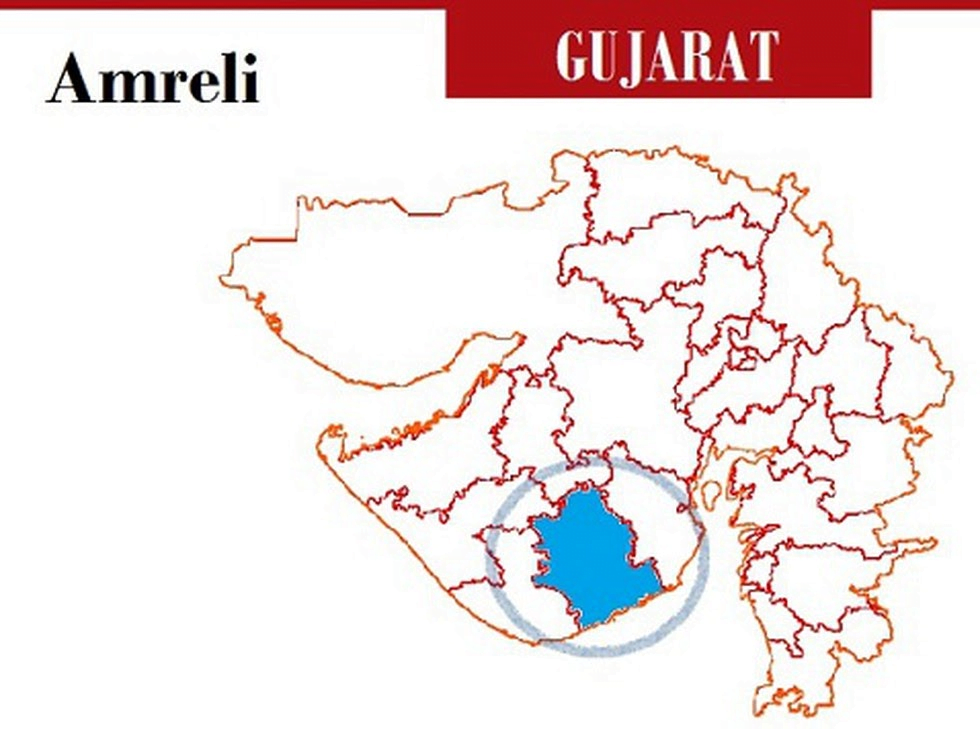
Key takeaways
- This will take the state’s revenue services nearer to the people and provide services faster.
- The newly created Bagasara Prant would come into effect on 26th January, which includes Bagasara and Vadiya talukas in it.
- Since the districts with larger geographical areas cause inconvenience to the people, the state government has been reorganizing smaller districts and talukas for administrative convenience, faster development, reducing workload as well as saving the people’s time.
Do you know?
- Prants are traditional names for parts of historical regions, such as the original ten regions of Kathiawad on Saurashtra peninsula in Gujarat.
Freight Business Development Portal
Part of: GS Prelims and GS-III – Infrastructure
In news
- Freight Business Development Portal was recently launched as one stop solution for all the needs of freight customers.
- Ministry: Ministry of Railways
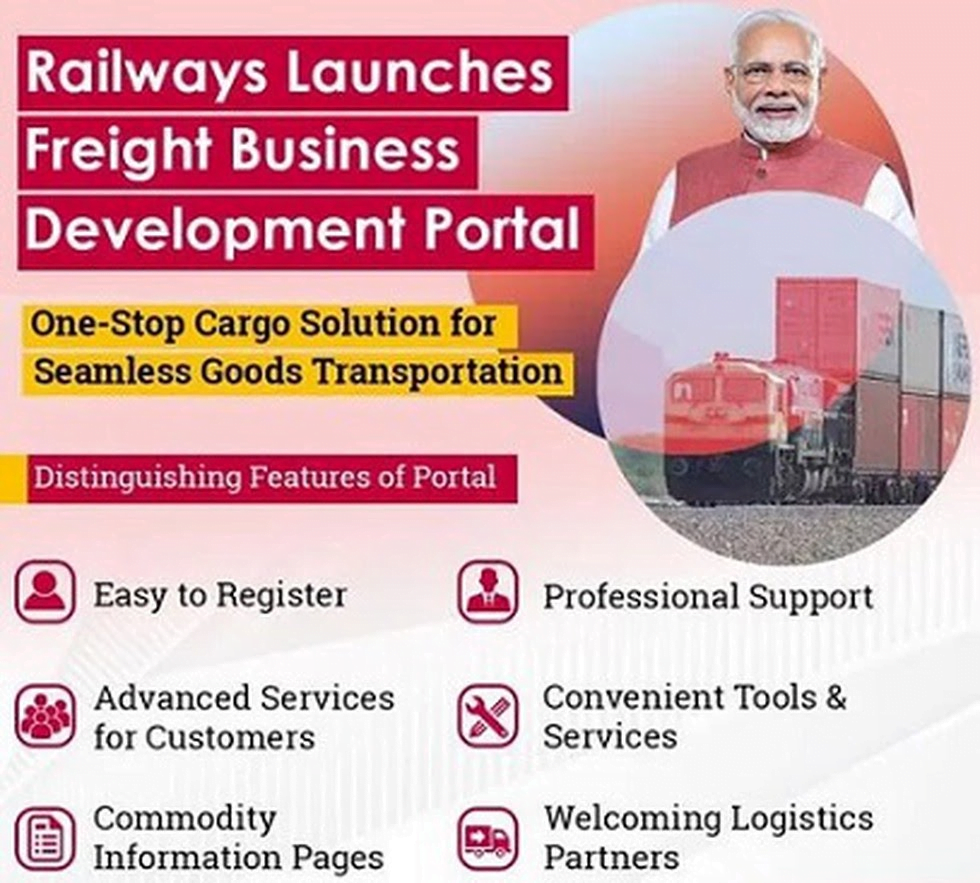
Key takeaways
- The portal is designed to replace physical processes with online ones to minimise the need of human-to-human interaction.
- it will help them use rail mode seamlessly.
- The personalised dashboard of freight business portal provides customers a view with their business in railways, outstanding indents, on-run consignments, status of various interactions and facility to apply for various services and raising concerns.
- Customers also get to know about discount schemes, diversion, rebooking, demurrage and wharfage waivers, stacking permissions.
Maximum speed of Golden Quadrilateral – Golden Diagonal (GQ-GD) route enhanced
Part of: GS Prelims and GS-III – Infrastructure
In news
- Indian Railway has started the New Year by achieving a landmark achievement by drastically enhancing the maximum speed to 130 kmph for 1,280 km length out of 1,612 Km in Golden Quadrilateral – Golden Diagonal (GQ-GD) route.

Key takeaways
- This covers the entire GQ-GD route over South Central Railway, except Vijayawada – Duvvada section, where signalling up-gradation work is in progress.
- The enhanced speed limits could be achieved due to the systematic and planned strengthening of track & its infrastructure by removing bottlenecks in these sections on a fast pace.
- This included heavier rails, laying of 260 meters Long welded rail panels, improvement of curves and gradients among others.
- Already, the maximum speed limits in the High-Density Network (HDN) between Secunderabad – Kazipet (132 Kms distance) had been enhanced to 130 kmph.
Important value additions
- The Golden Quadrilateral (GQ) is a national highway network connecting most of the major industrial, agricultural and cultural centres of India.
- It forms a quadrilateral connecting the four major metro cities of India, viz., Delhi (north), Kolkata (east), Mumbai (west) and Chennai (south).
- It is the largest highway project in India and the fifth longest in the world.
- It is the first phase of the National Highways Development Project (NHDP), and consists of four- and six-lane express highways, built at a cost of ₹600 billion.
- Planned in: 1999; Launched in: 2001; Completed in: 2012
- The Golden Quadrilateral project is managed by the National Highways Authority of India (NHAI) under the Ministry of Road, Transport and Highways.
Miscellaneous
Cherry Blossom Mao Festival
- In Manipur, the Cherry Blossom Mao Festival was held at Senapati district marking the beginning of pink season in the district.
- The Mao area of Senapati district in Manipur is known for Cherry Blossom, a plant which is popularly known as Sakura in Japan.
- The festival features the picturesque landscape of Mao town adorned with beautiful Cherry Blossom flowers.
- A cherry blossom is a flower of many trees of genus Prunus.
- Prunus cerasoides, called wild Himalayan cherry, Indian wild cherry, and sour cherry, is known in Hindi as padam, pajja, or padmakashtha.
(Mains Focus)
ECONOMY/ GOVERNANCE
Topic: General Studies 3:
- Indian Economy and issues relating to planning, mobilization, of resources, growth, development and employment.
- Monetary Policy of RBI
Planning an exit out of the easy money regime
Context: The Reserve Bank of India (RBI) embarked on an extraordinary expansionary policy to manage the financial pressures unleashed by COVID-19, some of which are:
- It slashed policy interest rates aggressively
- Flooded the market with an unprecedented amount of liquidity
- Instituted a slew of measures for targeted assistance to especially distressed sectors.
As we sight springshoots in the economy, the RBI must be planning for a non-disruptive exit out of the easy money regime.
What are the challenges that the RBI will confront on the way out?
- It should be deliberative process: When the economy is in crisis, central banks go for expansionary policy often shedding their characteristic deliberation. In contrast, reversing a crisis-driven expansionary policy has to be a deliberative process, with the timing and sequencing carefully planned.
- Learning from 2008 Financial Crisis: Indeed, one of the big lessons of the global financial crisis is that any missteps on the exit path by way of commission, omission, or importantly communication, can be costly in macroeconomic terms. The lesson from the taper tantrums of US is that the RBI will have to manage its communication as carefully as it does the liquidity withdrawal.
- Absorption capacity of system: Banks are routinely depositing trillions of rupees with the RBI every day, evidencing that all the money that the central bank unleashed into the system is not doing much good anymore
- Dangers of easy money to Financial Stability: Mispricing of risk is the result when there is too much liquidity sloshing around the system for too long. It will drive investors into dodgy ventures and threaten financial stability.
- Restrain the rupee from appreciating out of line with fundamentals: Here, the RBI is confronted with a classic case of ‘the impossible trinity’ — of keeping doors open for capital flows while simultaneously maintaining a stable exchange rate and restraining inflation. Maintaining a policy balance across all three conflicting objectives can be tricky.
- Policy dilemma for RBI: The biggest challenge for RBI while planning an exit strategy will be to manage the tension between restraining inflation and supporting the recovery.
- Plight of Savers: Quite apart from the upside risks to inflation and downside risks to growth, the RBI should also be concerned about the plight of savers who are being shortchanged by low interest rates at a time of high inflation. All these concerns taken together make a complex cocktail of dilemmas for the RBI as it seeks to normalise the policy rates.
Dilemma for RBI between Inflation Vs Recovery
- Inflation above Target Band: Inflation remained above the RBI’s target band for the past several months, and according to the RBI’s own estimates, is expected to remain above the band for the next several months.
- Recovery concern of RBI: Despite inflation concerns, the Monetary Policy Committee of RBI decided against any rate action out of concerns for growth and financial stability.
- RBI’s expectation of Inflation Softening: The MPC expects inflation to soften on its own in the weeks ahead as supply chains, disrupted by the lockdown, normalise, and the bumper winter crop comes into the market.
- Concerns with RBI’s expectation of Inflation Softening: Excessive margins, among the factors cited by the MPC as one of the causes of high inflation, may not disappear if firms, regaining pricing power amid demand recovery, raise prices to mend their balance sheets.
- Risk of Inflation Persisting: There is the risk that persistent high inflation expectations would result in food inflation getting more generalised. Core inflation could firm up because of rising input prices.
- Recovery Concerns: Equally, there are concerns that the recovery, for all the positive signals, is still fragile. It has also been uneven and unequal, with large industries finding their foothold while small and medium enterprises and the entire informal sector continue to be in distress.
Conclusion
- It is better to be rough right, as Keynes said, than be precisely wrong. That should be the guiding principle for RBI as it navigates its way out of the crisis driven easy money policy.
Connecting the dots:
- The problem with liquidity push: Click here
INTERNATIONAL/ SECURITY
Topic: General Studies 2:
- India and its neighborhood- relations.
- Security challenges and their management in border areas
Political Crisis in Nepal
Context: Nepal has drifted into a political crisis following its Prime Minister (PM) KP Sharma Oli’s decision to dissolve Parliament, a move promptly approved by President Bidhya Devi Bhandari.
Oli also announced general elections would be held in April and May 2021, more than a year ahead of schedule
A brief background of Nepal’s Political Parties
- Three major parties dominate Nepal’s politics: Nepali Congress Party; Communist Party of Nepal-Unified Marxist Leninist led by Oli, and Nepal Communist Party (Maoist) led by Prachanda
- Prachanda led the Maoist insurgency for a decade (1996-2006) before joining mainstream politics. Oli was a fierce critic of the politics of violence that caused more than 17,000 deaths.
- But Oli approached the Maoists in 2017 for a merger between their parties, pre-empting the possibility of an alliance between the Maoists and the Nepali Congress that may have come in the way of Oli’s prime ministerial ambitions.
- Following the merger, the two leaders agreed that they would lead the government by turn, a promise that Oli did not honour at the end of his two-and-a-half years, thus sowing the seeds of separation.
- Now, as a split appears inevitable, Oli is hoping to continue in power with those following him.
Critical Analysis of the Dissolution of Parliament
- Reasons for Oli’s decision: Oli took the step when he realised that a factional feud within the party had reached the point of no return and he faced possible expulsion both as party chief and as Prime Minister
- End of Coalition: Dissolution of Parliament effectively ended the unity forced among the left forces that had led to the creation of the single, grand Nepal Communist Party three years ago
- Uncertainty over Nepal’s new Constitution: Dissolution of the House is not new in Nepal, but this is the first such instance after the new Constitution of 2015 that places safeguards against dissolution. The new constitution does not envisage such a step without exploring formation of an alternative government
- Accountability of caretaker government: The dissolution came hours before a Standing Committee meeting that was expected to order a probe into corruption charges levelled against him by party co-chairman Pushpa Kamal Dahal Prachanda. With Parliament dissolved and with a President seen as favourable to him, Oli will have the power to rule without being accountable to none.
- The Army: The Nepal Army has made it clear that it will remain neutral in the ongoing political developments. This implies that if Oli tries to rule with the help of security forces to maintain law and order and contain protests, it is uncertain how far the Army will play along.
- The China Factor: China has been a big factor in Nepal’s internal politics since 2006. It is seen as having lobbied, visible or secret, to prevent the split. China has also invested in crucial sectors like trade and Investment, energy, tourism and post-earthquake reconstruction, and is Nepal’s biggest FDI contributor
- Judiciary’s decision awaited: Since dissolution, a dozen petitions have been filed in the Supreme Court challenging the dissolution with two years left of the present House’s tenure. The constitutional validity of Oli’s move has been questioned, and is awaiting decision by the Supreme Court.
How India handled this Political Crisis?
- Ire not directed at India: Unlike on previous occasions, Oli has refrained from blaming India for destabilising his regime. The PM’s ire has been directed at his senior party colleagues for not allowing him to govern smoothly.
- India’s subtle support to Oli: Anti-Oli forces were quietly cheered to dump him, but when they failed, India subtly extended a helping hand to a desperate Oli struggling for survival. PM Modi positively responded to Oli’s telephonic greetings on India’s Independence Day. A series of important visits from India followed.
- Continuing bilateral relationship: Energy and trade officials from the two countries have met each other, border talks are on board, and Nepal’s foreign minister is visiting India for the joint commission
- India has achieved its tactical goals: Through these moves, India has achieved its immediate tactical goals. Oli has been emboldened to stick to power even by breaking the party. In the process, the shallowness of Oli’s opportunistic and politically driven anti-Indian nationalism has been exposed.
- Embarrassment to China: India has played its cards cautiously and craftily. With an assiduously cultivated façade of non-interference, it let China smear itself into the mud of micromanaging the ruling party’s internal conflicts. The unity and dominance of the ruling Nepal Communist Party (NCP) has been shattered, and China, as its patron, has been embarrassed.
- Support for elections: On the sidelines of these developments, India has also fuelled and fed Hindutva forces under the leadership of a discarded monarchy, possibly as a ploy in the unfolding realignment of political forces in Nepal. Towards that end, India has now come out openly in favour of fresh elections.
Critical Analysis of India’s moves in Nepal Political Crisis
- All this puts India on the side of undemocratic, unconstitutional and opportunistic players in Nepal, which South Block strategists think is a small price to be paid for the significant gains otherwise made.
- Seeking a friendly regime in the neighbourhood is a recognised norm in the realist world of international relations. India is no exception. It has often invested heavily in Nepal to have a friendly, even a pliant, regime.
- But in the long-term, this approach has largely resulted in the erosion, rather than consolidation, of India’s vital security and economic interests.
- With China deeply pitched in the regime change business in Nepal, prospects of this approach in coming years seem expensive and uncertain.
Way Ahead for India
- Let Nepal deal with its internal mess: Irrespective of whether Nepal has elections or witnesses the restoration of Parliament, a prudent course for India would be to let Nepal cope with its internal political mess.
- Improve its own popular profile: As no major development in bilateral relations appears likely during the prevailing uncertainty, India must encourage consolidation of a people-driven polity, and improve its own popular profile.
- Resolve Controversial Issues: India can pick up pending controversial issues such as the 1950 treaty, the Kalapani border dispute, and trade and investment matters, and categorical state its position, drawing red lines that Nepal should not cross.
- New Indo-Nepal Treaty: Nepal has asked for a revision of the 1950 treaty, and this has been accepted by India. But the issue remains stuck because Nepal does not clarify how to strike a proper balance between India’s security concerns and Nepal’s developmental aspirations. Without this balance, no new treaty is possible, and Nepal, seemingly, is not prepared to abrogate the old treaty.
- India’s Stand should be made clear: India’s policy towards immediate neighbours has never been driven by territorial nationalism. This has been evident in the case of Sri Lanka (Katchatheevu), Bangladesh (territorial waters), and even Pakistan and China.
- Bridge trade imbalance: On trade and investment issues, India needs to be more accommodative. Nepal sells less than $1billion worth of products to India while importing nearly $8 billion of them. This is unsustainable, despite the fact that trade deficits are governed by the nature of economies. India can and must move to remove structural and procedural impediments to the entry of genuine Nepali goods into Indian markets
- China Factor: In redefining India’s approach to Nepal, India also needs to shed a great deal of its Sinophobia. China is no doubt politically assertive and financially spread out in Nepal, but most of its promises, such as transit through Chinese ports and railroad connections, are politically driven.
Connecting the dots:
- India- Nepal Border dispute at Kalapani and Lipulekh: Click here
(TEST YOUR KNOWLEDGE)
Model questions: (You can now post your answers in comment section)
Note:
- Correct answers of today’s questions will be provided in next day’s DNA section. Kindly refer to it and update your answers.
- Comments Up-voted by IASbaba are also the “correct answers”.
Q.1 Consider the following statements regarding Vanadium:
- The elemental metal is rarely found in nature.
- The metal is used in strengthening steel and titanium.
Which of the above is/are correct?
- 1 only
- 2 only
- Both 1 and 2
- Neither 1 nor 2
Q.2 Which of the following state is likely to become India’s prime producer of vanadium?
- Assam
- Maharashtra
- Gujarat
- Arunachal Pradesh
Q.3 Consider the following statements regarding
- LiDAR is a remote sensing method that uses light in the form of a pulsed laser to measure ranges to the Earth.
- It generates precise, three-dimensional information about the shape of the Earth and its surface characteristics.
Which of the above is/are correct?
- 1 only
- 2 only
- Both 1 and 2
- Neither 1 nor 2
Q.4 Which of the following country is the only country in the world producing all Five major types of silk?
- India
- China
- Japan
- USA
ANSWERS FOR 9th January 2021 TEST YOUR KNOWLEDGE (TYK)
| 1 | A |
| 2 | D |
| 3 | A |
| 4 | D |
| 5 | A |
Must Read
On electric mobility and India:
On vaccines and Public Trust:
About ongoing farmers protests and need for resolution:












